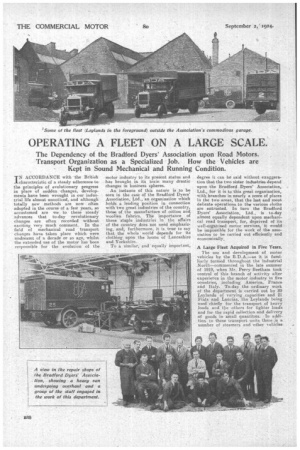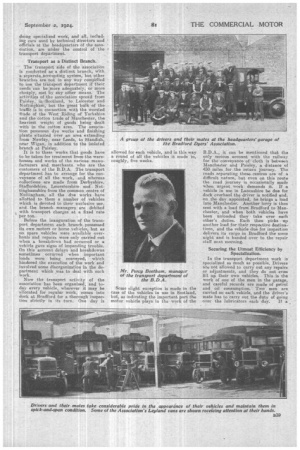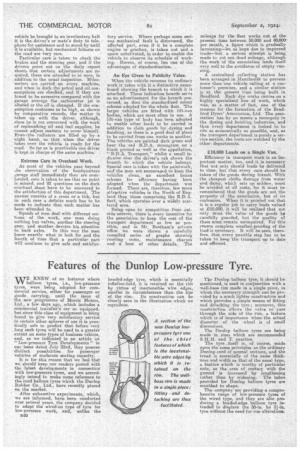OPERATING A FLEET ON A LARGE SCALE.
Page 20

Page 21

Page 22

If you've noticed an error in this article please click here to report it so we can fix it.
The Dependency of the Bradford Dyers Association upon Road Motors. Transport Organization as a Specialized Job. How the Vehicles are Kept in Sound Mechanical and Running Condition.
TN ACCORDANCE with the British -I-characteristic of a steady adherence to the principles of evolutionary progress in place of sudden changes, developments have been wrought in our industrial life almost unnoticed, and although totally new methods are now often adopted in the course of a few years, so accustomed are we to these steady advances that to-day revolutionary changes are often recorded without exciting very much comment. In the field of mechanical road transport changes have taken place which were undreamt of a decade or so ago, whilst the extended use of the motor has been responsible for the evolution of the
motor industry to its present status and has brought in its train many drastic i changes n business spheres.
An instance of this nature is to be seen in the case of the Bradford Dyers' Association, Ltd., an organization which holds a leading position in connection with two great industries of the country, those of the manufacture of cotton and woollen fabrics. The importance of these staple industries in the affairs of the country does not need emphasizing, and furthermore, it is true to say that the whole world depends for its clothing upon the looms of Lancashire and Yorkshire.
To a similar, and equally important degree it can be said without exaggeration that the two sister industries depend upon the Bradford Dyers' Association, Ltd., for it is to this great organization, with branches in nearly a score of places in the two areas, that the last and most delicate operations to the various cloths are entrusted. In turn the Bradford Dyers' Association, Ltd., is to-day almost equally dependent upon mechanical road transport, for, deprived of its well-organized motor services, it would be impossible for the 1.aork of the association to be carried out efficiently and economically.
A Large Fleet Acquired in Five Years.
The use and development of motor vehicles by the B.D.A.—as it is familiarly termed throughout the industrial North—commenced in the late summer of 1919, when Mr. Percy Beetham took control of this branch of activity after experience in the motor industry in five countries, including America„ Fiance and Italy. To-day the ordinary work of the department is carried out by 139 Leylands of varying capacities and 21 Fiats and Lancia,s, the Leylands being used chiefly for the transport of heavy loads and the others for lighter loads and for the rapid collection and delivery of goods in small quantities. In addition to these transport units there is a number of steamers and other vehicles
doing specialized work, and all, including cars used by technical directors and ' officials at the headquarters of the association, are under the control of the transport department. • Transport as a Distinct Branch.
• The transport side of the association is conducted as a distinct branch, with a peparate..aceounting system, hut other branches are not in any way cemPelled to Use the transport department if their need S can be more adequately, or more cheaply, met by any other means.. The aativities of the association spread from Paisley, in••Scotland, to Leicester and• Nefting,harrs, but the great bulk of the traffic is in connection with the worsted rrade of the West Riding of Yorkshire and the cotton trade of Manchester, the heaviest weight of goods being dealt with in the cotton area. The association possesses dye works and finishing plants situated over an area extending from Newlay, near Leeds, to Standish, near Wigan, in addition to the isOlated branch at Paisley.
It is to these works that goods have to be taken for treatment from•the warehouses and works of the various manufacturers and merchants who are the customers of the B.D.A. The transport department has to arrange for the conveyance of all the work, and whereas collections are made from Derbyshire, Staffordshire, Leicestershire and Nottinghamshire from the common centre of Nottingham, all the dye works have allotted to them a number of vehicles which is devoted to their exclusive use, and the branch managers are debited with transport charges at a fixed rate per ton..
Before the inauguration of the transport department each branch p_ossessed its own motors or horse vehicles, but as no spare vehicles were available overhauls and repairs were only carried out when a breakdown had occurred or a vehicle gave signs of impending trouble. On this account delays and breakdowns sometimes occurred when important loads were being , conveyed, which hindered the execution of the work and involved some disorganization in the department which was to deal with such Now the transport activity of the association has been organized, and today every vehicle. wherever it may be allocated for regular work, comes into dock at Bradford for a thorough inspec. tion strictly in its turn. One day is allowed for each vehicle, and in this way a round of all the vehicles it made in, roughly, five weeks.
Some slight exception is made in the case of the vehicles in use in Scotland, but, as indicating the important part the motor vehicle plays in the work of the B.D.A., it can be mentioned that the only serious account with the railway for the conveyance of Cloth is between
• Manchester and Paisley, a distance of 450 miles. for the return journey. The . roads separating these centres are of a difficult nature, but even on this route the road journey is occasionally made when urgent work demands it. If a vehicle in use in Lancashire be due for dock overhaul the driver is notified and, on the day appointed, he brings a load into Manchester. Another lorry is then sent with a load from Bradford to Manchester, and when both vehicles have been unloaded they take over each other's duties. Each then picks up another load for their respective destinations, and the vehicle due for inspection delivers its cargo in Bradford the same night and is handed over to the repair staff next morning.
Securing the Utmost Efficiency by Specialization.
In the transport department work is specialized as Much as possible. Drivers are not allowed to carry out any repairs or adjustments, and they do not even fill up their own vehicles. This is the work of one of the men in the garage, and careful records are made of petrol and oil. consumption. Two men are carried on each vehicle, and the driver's mate has to carry out the duty of going
over the lubricators each day. IF a vehicle be brought to an involuntary halt it is the -driver's or mate's duty to telephone for assistance and to stand-by until it is available, but mechanical failures on the road are very rare.
Particular care is taken to check the brakes and the steering gear, and if the drivers point out on the daily report sheets that certain adjustments are required, these are attended to at once, in addition to the usual inspection. Mileometers are carried on every machine, and when in dock the petrol and oil consumptions are checked, and if they are found to be excessive compared with the garage average the carburetter jet is altered or the oil is changed. If the consumption continues to be high, as shown by comparative records, the matter is taken up with the driver, although, since he is not concerned with the work of replenishing oil and fuel supplies, he cannot adjust matters to cover himself. Evenethe radiators are filled up by a night hand, so. that ;when the' driver takes over the vehicle is ready for the road. So.far as is practicable one driver is kept-in charge of the smile maehine.
Extreme Care in Overhaul Work.
As Most of the vehicles pass beyond , vile observation of the headquarters garage staff immediately they are overhauled, care is taken to see that. no point is missed, and 92 questions on the dock overhaul ;sheet have to be answered to the satisfaction of this department, The answer consists of a cross or a tick, but in each case a definite mark has to be made to indicate that each matter has been attended to, Squads of men deal with different sections of the work, one man doing nothing but valves, another the steering gear, and another devotes his attention to back atles. In this way the men know exactly what to look for and the length of time that a particular part will continue to give safe and satisfac
toe), service. Where perhaps some serious mechanical fault is discovered, the affected part, even if it be a complete engine or gearbox, is taken out and a spare substituted, in order to enable the vehicle to observe its schedule of working. Herein, of course, lies one of the advantages of standardization.
An Eye Given to Publicity Value.
When the vehicle resumes its ordinary work it takes with it a distinctive nameboard showing the branch to which it is attached. These indication boards serve as an advertisement for the branch concerned, as does the standardized colour scheme adapted for the whole fleet. 'The larger vehicles are fitted with lift-van bodies, which are most often in use, A lift-van type of body has been adopted to enable other loads to be carried in addition to cloth goods for dyeing and finishing, as there is a good deal of plant to be carried from one .works to another. The vehicles are painted dark green and bear the red BOA, monogram on a black ground as well as the appellation, "B.D.A., Transport," whilst a small indicator over the driver's cab shows the branch to which the vehicle belongs. Special care is taken with the paintwork, and the men are encouraged to keep the vehicles clean, an excellent bonus scheme for efficiency having been adopted when the department was formed. There are, therefore, few more attractive vehicles in the North of England than those comprising the B.D.A. fleet, which operates over a widely scattered area.
Being open to competition from outside sourees, there is every incentive for the association to keep the cost of the transport department as low as possible, and in Mr, Beetham's private office we were shown a carefully compiled series of graphs showing running costs, maintenance charges and a host of other details. The
mileage for the fleet works out at the present time between 30,900 and 40,000 per month, a figure which is gradually increasing—let us hope due to improved trade—hut a serious attempt is being made to cut out dead mileage, although the -work of the association lends itself very well to the avoidance of empty running.
A centralized collecting station has been arranged in Manchester to prevent more than one vehicle calling at a customer's premises, and a similar station is at the present time being built in Bradford. Each dye works carries on a highly specialized line of work, which was, as a matter of fact, one of the reasons for the formation of the Bradford Dyers' Association, Ltd. The association has by no means a monopoly in the dyeing and finishing industries, and time every department is looked to to run as economically as possible., and, as the transport department is purely a service section, the bl$is are watched by the other departments.
£.10,000 Loads on a Single Van.
Efficiency in transport work is an important matter, too, and it is necessary that not only should loads be delivered to time, but that every care should be taken of the goods during transit. With the cheapest cloths damage from water and damp, which sets up mildew, must, be avoided at all costs, for it must be remembered that the goods are not the property of the association, but of its customers. When it is pointed out that it is a regular job to carry loads valued at £10,000, it will be realized that not only must the value of the goods 'be carefully guarded, but the quality of them must remain unimpaired. For this reason complete weather-proofing of the load is necessary. It will be seen, therefore, that every possible step has to be taken to keep the transport up to date and efficient.






























